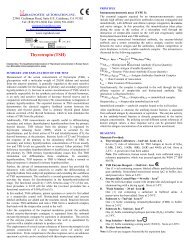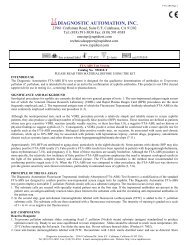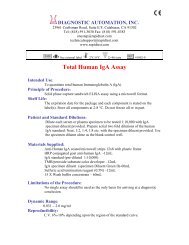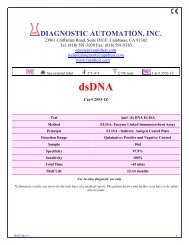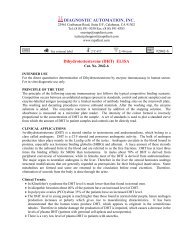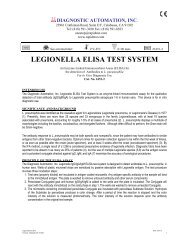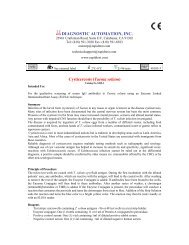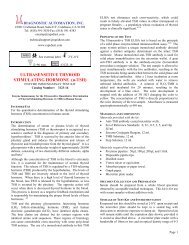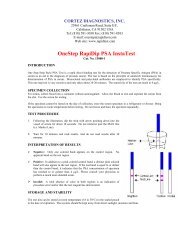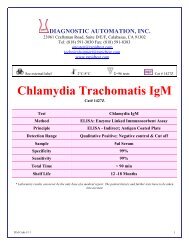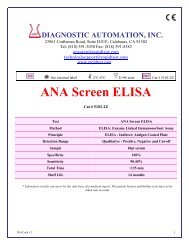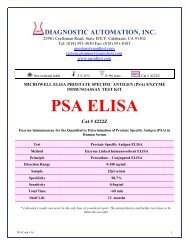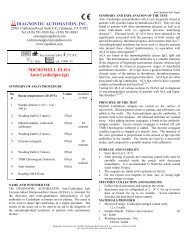DIAGNOSTIC AUTOMATION, INC. - Diagnostic Automation : Cortez ...
DIAGNOSTIC AUTOMATION, INC. - Diagnostic Automation : Cortez ...
DIAGNOSTIC AUTOMATION, INC. - Diagnostic Automation : Cortez ...
Create successful ePaper yourself
Turn your PDF publications into a flip-book with our unique Google optimized e-Paper software.
<strong>DIAGNOSTIC</strong> <strong>AUTOMATION</strong>, <strong>INC</strong>.<br />
23961 Craftsman Road, Suite E/F, Calabasas, CA 91302<br />
Tel: (818) 591-3030 Fax: (818) 591-8383<br />
onestep@rapidtest.com<br />
technicalsupport@rapidtest.com<br />
www.rapidtest.com<br />
See external label 2°C-8°C Σ=96 tests #8202-3<br />
Echinococcus Microwell Serum ELISA<br />
Catalog No. 8202-3<br />
Intended Use<br />
For the qualitative screening of serum IgG antibodies to Echinococcus sp. using an Enzyme-Linked Immunosorbent Assay<br />
(ELISA) technique.<br />
Summary<br />
Echinococcosis (hydatidosis) is the infection caused by cestodes of the genus Echinococcus. Humans are potential intermediate<br />
hosts and can become infected by ingesting eggs passed in the feces of an infected animal. The resulting disease is called<br />
hydatidosis, or hydatid disease.<br />
Four species are known pathogens of the disease: E. granulosus, E. multilocularis, E. oligarthrus and E. vogeli. The infection<br />
caused by E. granulosus is referred to as cystic hydatid disease (CHD) and results in cysts in various organs, especially the liver<br />
and lungs. These cysts may become quite large and contain hundreds or thousands of scoleces called hydatid sand. The degree<br />
of antibody response to these cysts will vary depending on their location and degree of calcification. Liver cysts typically<br />
produce a higher antibody response than lung cysts. Infection due to E. multilocularis is referred to as alveolar hydatid disease<br />
(AHD), and also occurs as cysts that may spread throughout the infected tissue.<br />
Since Echinococcus eggs are not shed by infected humans, serological determination has been important in the diagnosis of<br />
hydatid disease. A number of tests have been used, including latex agglutination (LA), indirect hemagglutination (IHA),<br />
complement fixation (CF), agar gel diffusion (AGD) and enzyme linked immunosorbent assay (ELISA).<br />
Cross reactivity between echinococcosis and cysticercosis (Taenia solium infection) will occur to some degree in this assay due<br />
to the use of crude antigen. It is recommended that any sample showing a positive result by this test be confirmed by additional<br />
testing.<br />
Principle of Procedure<br />
The micro test wells are coated with a crude antigen from an Echinococcus cyst. During the first incubation with the diluted<br />
patients’ sera, any antibodies which are reactive with the antigen will bind to the coated wells. After washing to remove the rest<br />
of the sample, the Enzyme Conjugate is added. If antibodies have been bound to the wells, the Enzyme Conjugate will then bind<br />
to these antibodies. After another series of washes, a chromogen (tetramethlybenzidine or TMB) is added. If the Enzyme<br />
Conjugate is present, the peroxidase will catalyze a reaction that consumes the peroxide and turns the chromogen from clear to<br />
blue. Addition of the Stop Solution ends the reaction and turns the blue color to a bright yellow color. The reaction may then be<br />
read visually or with an ELISA reader.<br />
Reagents<br />
• Test strips: microwells containing Echinococcus antigens - 96 or 48 test wells in a test strip holder.<br />
• Enzyme conjugate: One (1) bottle containing 11or 6 ml of Protein A conjugated to peroxidase.
• Positive control serum: One (1) vial containing 1 ml of diluted positive rabbit serum.<br />
• Negative control serum: One (1) vial containing 1 ml of diluted negative human serum.<br />
• Chromogen: One (1) bottle containing 11 ml of the chromogen tetramethylbenzidine (TMB).<br />
• Wash concentrate solution (20X): One (1) bottle containing 25 ml of concentrated buffer and surfactant.<br />
• Dilution buffer: Two (2) or one (1) bottle(s) containing 30 ml of buffered protein solution.<br />
• Stop solution: One (1) bottle containing 11 ml of 1 M phosphoric acid.<br />
Precautions<br />
Do not use solutions if they precipitate or become cloudy. Wash concentrate may show crystallization upon storage at 2-8º C.<br />
Crystallization will disappear after dilution to working strength.<br />
Do not use serum that may have supported microbial growth, or is cloudy due to high lipid content. Samples high in lipids<br />
should be clarified before use.<br />
Treat all sera as if capable of being infectious. Negative control has been tested and found negative for Hepatitis B surface<br />
antigen and for the antibody to HIV by required test methods. This product should be used under appropriate safety conditions<br />
that would be used for any potentially infectious agent.<br />
Do not add azides to the samples or any of the reagents.<br />
Storage Conditions<br />
Reagents, strips and bottled components:<br />
Store between 2 - 8º C.<br />
Squeeze bottle containing diluted wash buffer may be stored at room temperature.<br />
Preparation<br />
Wash Buffer - Remove cap and add contents of bottle to 475 ml of reagent grade water. Place diluted wash buffer into a squeeze<br />
bottle with a narrow tip opening.<br />
Note: Washings consist of filling to the top of each well, shaking out the contents and refilling.<br />
Avoid generating bubbles in the wells during the washing steps.<br />
Collection and Preparation of Serum<br />
Coagulate blood and remove serum. Freeze sample at -20º C or lower if not used immediately.<br />
Do not heat inactivate serum and avoid repeated freezing and thawing of samples.<br />
Test samples: Make a 1:64 dilution of patients sera using the dilution buffer (e.g. 5 μl sera and 315 μl dilution buffer).<br />
Materials Provided<br />
Echinococcus Serology Microwell ELISA Kit<br />
Procedure<br />
Materials Required But Not Provided<br />
Pipettes<br />
Squeeze bottle for washing strips (narrow tip is recommended)<br />
Reagent grade water and graduated cylinder<br />
Tubes for sample dilution<br />
Absorbent paper<br />
Suggested Materials<br />
ELISA plate reader with a 450 nm and a 650 to 620 nm filter (optional if results are read visually)
Performance of Test<br />
1. Break off number of wells needed (two for controls plus number of samples) and place in strip holder.<br />
2. Add 100 μl (or two drops) of the negative control to well #1, 100 μl of the positive control to well #2 and 100 μl of the<br />
diluted (1:64) test samples to the remaining wells.<br />
Note: Negative and positive controls are supplied prediluted. Do not dilute further.<br />
3. Incubate at room temperature (15 to 25º C) for 10 minutes.<br />
4. Shake out contents and wash 3 times with the diluted wash buffer.<br />
5. Add 2 drops of Enzyme Conjugate to each well.<br />
6. Incubate at room temperature for 5 minutes.<br />
7. Shake out contents and wash 3 times with wash buffer.<br />
8. Slap wells vigorously against paper towels to remove excess moisture.<br />
9. Add 2 drops of the Chromogen to every well.<br />
10. Incubate at room temperature for 5 minutes.<br />
11. Add 2 drops of the Stop Solution and mix by tapping strip holder.<br />
Reading of Results<br />
Visually: Look at each well against a white background (e.g. paper towel) and record as clear or +, ++ or +++ reaction.<br />
ELISA Reader: Zero reader on air. Set for bichromatic readings at 450/650-620 nm.<br />
Test Limitations<br />
Serologic results are an aid in diagnosis but cannot be used as the sole method of diagnosis.<br />
Quality Control<br />
The use of controls allows validation of kit stability. The kit should not be used if any of the controls are out of range.<br />
Expected values for the controls are:<br />
Negative - 0.0 to 0.3 OD units<br />
Positive - 0.5 OD units and above<br />
Troubleshooting<br />
Negative control has excessive color after development.<br />
Reason: inadequate washings.<br />
Correction: wash more vigorously. Remove excessive liquid from the wells by tapping against an absorbent towel.<br />
Do not allow test wells to dry out.<br />
Interpretation of Results - ELISA Reader<br />
Zero ELISA reader on air. Read all wells at 450/650-620 nm.<br />
Positive - Absorbance reading equal to or greater than 0.3 OD units.<br />
Negative - Absorbance reading less than 0.3 OD units.<br />
A negative OD reading indicates that the patient has no detectable level of antibodies. This may be due to lack of infection or<br />
poor immune response by the patient.
Interpretation of Results -Visual<br />
Compare results to the controls. A sample should be interpreted as positive if the degree of color development is significant<br />
and obvious.<br />
Expected Results<br />
The number of individuals showing positive results can vary significantly between populations and geographic regions. If<br />
possible, each laboratory should establish an expected range for its patient population.<br />
Performance Data<br />
Study #1 – CDC&P<br />
Sensitivity of 97.8% (46/47)<br />
Specificity – Liver Cancer 66.6% (8/12)<br />
Liver Abcess 66.6% (6/9)<br />
Normal 91.6% (11/12)<br />
Strongyloides 50% (3/6) (Strong cross reaction)<br />
Ascaris (0/6) (Strong cross reaction)<br />
References<br />
1. Schantz, P. and B. Gottstein. “Echinococcosis (Hydatidosis).” Immunodiagnosis of Parasitic Diseases, Vol. 1, Helminthic<br />
Diseases. Ed. Walls and Schantz. Academic Press, 1986. pp. 69-107<br />
2. Krogstad D., G. Visvesvara R. Walls, J. Smith. “Tissue Helminths.” Manual of Clinical Microbiology, 4th Ed.. American<br />
Society for Microbiology, Washington, DC. 1985, pp. 657-659<br />
3. Kagan, I. “Serodiagnosis of Parasitic Diseases.” Manual of Clinical Laboratory Immunology. 3rd Ed.. American Society<br />
for Microbiology, Washington, DC. 1986, p. 472<br />
4. Ash,L. and T. Orihel. “Parasites - A Guide to Laboratory Procedures and Identification.” 1987, ASCP Press, pp. 176-177<br />
5. Coltorti, E. “Standardization and Evaluation of an Enzyme Immunoassay as a Screening Test for the Seroepidemiology of<br />
Human Hydatidosis.” Am J Trop Med Hyg #35(5), 1986, pp. 1000-1005<br />
6. Coltorti, E. et. al. “Field Evaluation of an Enzyme Immunoassay for Detection of Asymptomatic Patients in a Hydatid<br />
Control Program.” Am J Trop Med Hyg, #38(3), 1988, pp. 603-607<br />
<strong>DIAGNOSTIC</strong> <strong>AUTOMATION</strong>, <strong>INC</strong>.<br />
23961 Craftsman Road, Suite E/F, Calabasas, CA 91302<br />
Tel: (818) 591-3030 Fax: (818) 591-8383<br />
ISO 13485-2003<br />
Revision Date: December 2003<br />
F/Insert/List B/Echinococcus_8202-3



